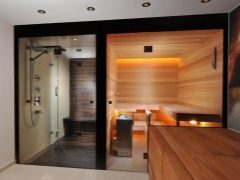Tile like wood in bathroom design

Wood is probably one of the most popular materials widely used not only in home construction, but also in interior design. In areas with a high level of humidity such material requires additional care, which further increases its cost, which is why the tiles under wood in the design of the bathroom is preferred and not inferior to natural wood.



Features
The texture and features of wood have always attracted fans of natural beauty, elegance and style.

In order to decorate your interior without much damage to the purse, manufacturers offer materials with wood imitation, in particular floor and wall tiles, which have a number of features and advantages:
- this option is excellent even in the bathroom, because it is not afraid of moisture;
- Unlike linoleum, tiles with wood imitation looks more presentable;
- after washing the surface will not remain streaks;
- The tile has a good wear resistance and durability;
- saves money and money, and the cost does not depend on the selected pattern.
The only disadvantage of this flooring is its cold surface, but this can also be corrected by the floor heating system.



Types
If we talk about types, there are floor and wall tiles with imitation wood. Floor tiles are rectangular in shape (repeats the outlines of a hardwood floor) and are designed for seamless masonry. Choosing a floor tile imitation wood, the buyer is faced with a huge variety of options for its laying. Therefore, manufacturers recommend to contact a professional for a higher quality installation.
Floor or wall tiles with wood imitation will be an excellent solution for the bathroom in African or eco-style, also it will be appreciated by lovers of eastern minimalism.



Type of material
In order to fully copy the hardwood flooring, as well as to create a vintage style in the bathroom, ceramic tiles are used. It is made of natural decorative material. It is made using clay, quartz sand, special substances to reduce the sintering temperature, as well as additives to improve the structure.

Ceramic tiles can be glazed (subjected to single or double firing) or unglazed.


One of the types of ceramic tiles, which has a relatively high strength, is porcelain tiles. Such tiles perfectly imitate wood and are made from natural material. Its composition combines kaolin white clay, feldspars, quartz sand, metal oxides, and thanks to natural dye pigments manufacturer receives the desired shade.
In addition to high strength, porcelain stoneware has excellent wear and frost resistance, so it can be used not only in the interior of the bathroom, but also in outdoor areas.



The peculiarity of glazed tiles is their external coating - it is thanks to this decorative layer is obtained such a variety of colors and textures. Tile has excellent wear resistance, does not deteriorate under the influence of chemicals, water, high or low temperatures. Such tiles do not burn out under UV light, they are easy to care for and are suitable for underfloor heating systems.

Mosaic is becoming increasingly popular in interior design, and bathrooms in particular. After all, if previously you had to glue each piece individually, but now manufacturers offer whole sheets of mosaic or individual panels. The most attractive solution is a mosaic on a grid.
The advantages of mosaics are easy to lay, high durability, resistance to moisture and drastic temperature changes. Ready-made layer can be easily cut and "fit" to the required size, as well as with the help of a mosaic tile can be implemented even the most exclusive design decisions.


Popular Colors
The color scheme of tiles for wood is varied, ranging from shades of bleached wood and ending with black shades (wenge).
Tiles of white and light colors is a win-win option, suitable for absolutely any interior. But in order to ensure that the bathroom does not look "sterile" clean, it is better to dilute it with colored interior details or a bright pattern.




Tiles of lettuce, neon-green, sunny yellow, turquoise, red and purple shades are also at the peak of popularity among buyers. Such bright shades are better diluted with other, more pastel and calm shades.

Design and textures
As a rule, wood tiles are a great addition to the country style, because the imitation board gives the bathroom a rustic look. Lovers of Thai or Oriental style will not be left out - wood perfectly harmonizes with natural stone or bamboo trellis.


For those who prefer ethnic style, designers suggest getting a sink or bathtub made of natural wood. The highlight of the design in the retro style is floor tiles with an imitation of a parquet board. A mosaic in this case will look great on wet areas (bath, shower or sink).

Tiles with imitation of scuffs, unevenly colored or with a brushed effect are gaining popularity. This solution in the bathroom will look very unusual and original.


Spanish manufacturers offer tiles with a glossy surface, which transforms the interior, adding luxury, sophistication and aesthetics. A new trend is glossy porcelain tiles in black shades, which, when combined with white tiles, adds contrast and pomp to the design of the bathroom.

More recently, manufacturers have begun to offer tiles with inscriptions. This theme is completely new and original in interior solutions. Lovers of classics this option will obviously not suit, but connoisseurs of modern style will appreciate it.

Sizes
There is a large number of tile sizes for any idea of interior design and they are all strictly regulated. Square tile size 30*30 (cm) is the most common for bathroom solutions, because it looks the most harmonious and gives the bathroom solidity and dignity.
No less convenient size for laying in the bathroom is a floor tile size 10*10. This format is easy to put on complex surfaces, ledges depressions and recesses. Tiles of square size are excellent for small bathrooms, not overloading their interior.
For porcelain tiles, the most common size is 15*60 (cm). Tiles of this size perfectly copes with the task of imitating a hardwood floor: it is long enough, but also of small thickness.



These are not the only sizes of porcelain tiles, manufacturers try to produce longer sizes depending on the chosen design and the area of the bathroom.

Manufacturers
The largest market share in the production of tiles is taken by the Russian company KERAMA MARAZZI, offering customers more than 2000 items. The peculiarity of this manufacturer is the emphasis on the countries of the world: each collection demonstrates the original features and unique style of a particular country or an entire continent.
The company manufactures porcelain stoneware using a special dry pressing technology, which most accurately imitates the natural material. Service remains at a high level: it is complemented by special applications for tablets, demonstrating in 3D-mode the entire range offered.



Among other advantages of this manufacturer it is worth noting the high quality of products, developed sales network, information service and wide use of innovative technologies in production.

Italian manufacturer FAP CERAMICHE produces the most elite and famous products that are in demand among people of high income. The main activity of this Italian company is imitation of natural material.


Choosing a tile from FAP CERAMICHE, you can be confident in the invariable quality of products, their environmental friendliness and resistance to abrasion. However, the manufacturer has a small size variation of up to 1 mm.

The leading place in the production of tiles in Spain is occupied by factories such as FANAL and PORCELANOSA. Spanish tiles are rightly recognized as the most durable, strongest and capable of implementing any design solution.
Tiles from these manufacturers are made of environmentally friendly materials, with a huge variety of colors, textures and shades. Its important feature is a monochrome surface with the addition of large inclusions, dustings or relief elements. This style adds "zest" and allows you to make every interior unique.



Laying technique
There are a huge number of laying techniques. One of the most common is the deck ("scattered"). Its meaning lies in the fact that the panels are laid with a shift of a row by 1/5 or 1/6 of the length of the tile itself. There are no difficulties in this case, and the figure can be laid even diagonally.


A little more difficult technique "Herringbone", because before starting the laying, it is recommended to mark the future position of the tiles. If the design of the bathroom involves this kind of laying, the most advantageous will look two shades that are in harmony with each other.

The chessboard technique is no less common. The name speaks for itself, and the resulting pattern does resemble a chessboard. Showing imagination, you can lay tiles of different textures or apply additional elements as edging.


An original and interesting type of laying is "Wicker". When choosing this laying technique, it is worth observing one single principle: it is necessary to create an imitation of the weaving of natural wood veneer.

When laying tiles with the "Well" technique, a three-dimensional effect will be obtained. This is the most spectacular wicker, combining a flight of fancy. However, for its embodiment, it is better to resort to the experienced hands of the master in view of the increased complexity of masonry.

Selection tips
Choosing high-quality tiles, it is worth paying attention to the marking. For example, tiles with high wear resistance (PEI) are marked as III or IV. Good chemical resistance is guaranteed by the marking AA or A. The optimal coefficient of friction is indicated by the number 11.
It is better to give preference to seamless tiles, that is, those that do not have chamfers on the edges. Such a feature allows you to get a wall or floor without gaps and seams. It is much more difficult to install because of the huge number of nuances, but the result will exceed all expectations: the surface will be like a mirror!


When choosing a color, we recommend the following principles:
- the feeling of cleanliness and neatness will give a tile of light and white shades;
- For a spacious bathroom it is better to choose such colors as: stained oak, cherry, dark zebrano;
- If the main task while decorating the walls is to visually expand the bathroom, it is better to choose light shades imitating birch or bleached oak;
- Moderate neutral shades (walnut, maple, ash) will give comfort and cosiness to the bathroom.



Examples in the bathroom interior
In a classic example of a country style bathroom, the walls and floor are finished with ceramic tiles of the same shade, perfectly imitating a plank. Decking on all surfaces adds authenticity. And the wooden doors on the washbasin add a farm or rustic feel to the room.

Lovers of Japanese or African motifs will suit a combination of bamboo panels, natural wallpaper, leather and stone tiles.

Similarly to the above example, you can recreate eco-style by combining wood tiles, natural wallpaper, pebbles and tiles with vegetal ornaments.

Lovers of modern style will like porcelain tiles like wood, creating an atmosphere of calm, restraint and conciseness.

Owners of spacious bathrooms can use tiles imitating wood to make accents, thereby highlighting some functional areas. Total masonry tiles of this type will make the room dark and gloomy, adding a sense of heaviness.

Tiles with imitation wood are an excellent alternative to natural wood coatings. With its correct application, it will be a winning option in the interior not only in the bathroom, but also in other rooms.







